In Vitro Fertilization Market Size
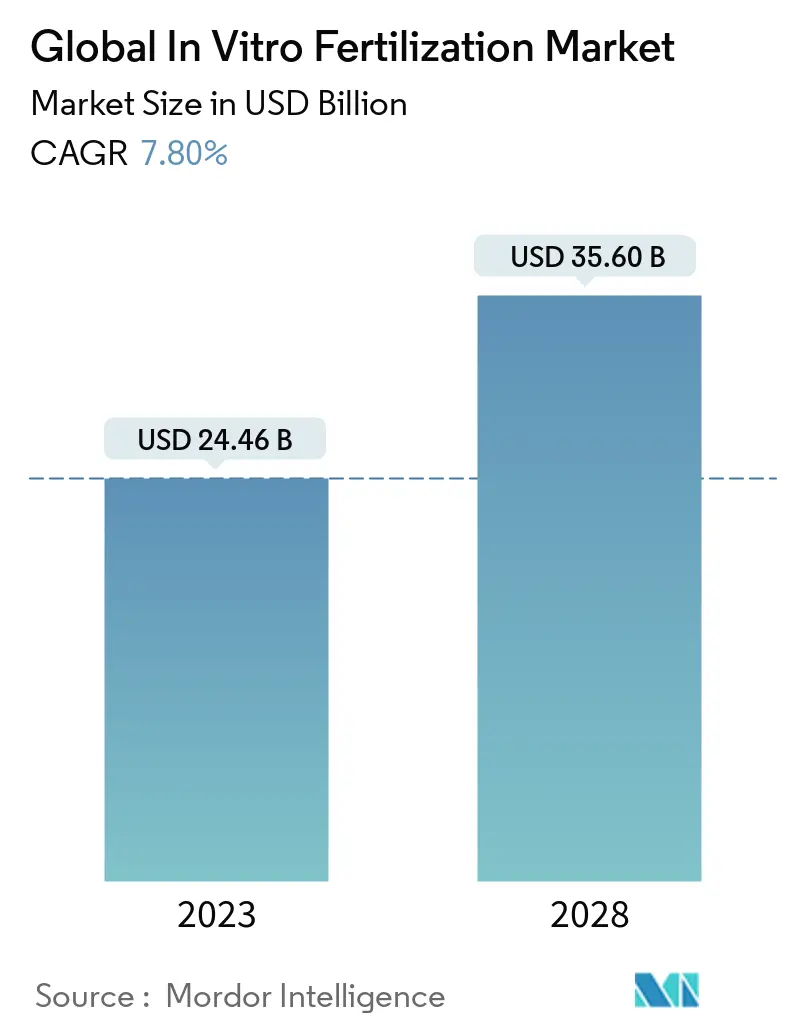
| Study Period | 2018 - 2028 |
| Market Size (2023) | USD 24.46 Billion |
| Market Size (2028) | USD 35.60 Billion |
| CAGR (2023 - 2028) | 7.80 % |
| Fastest Growing Market | Asia Pacific |
| Largest Market | North America |
Major Players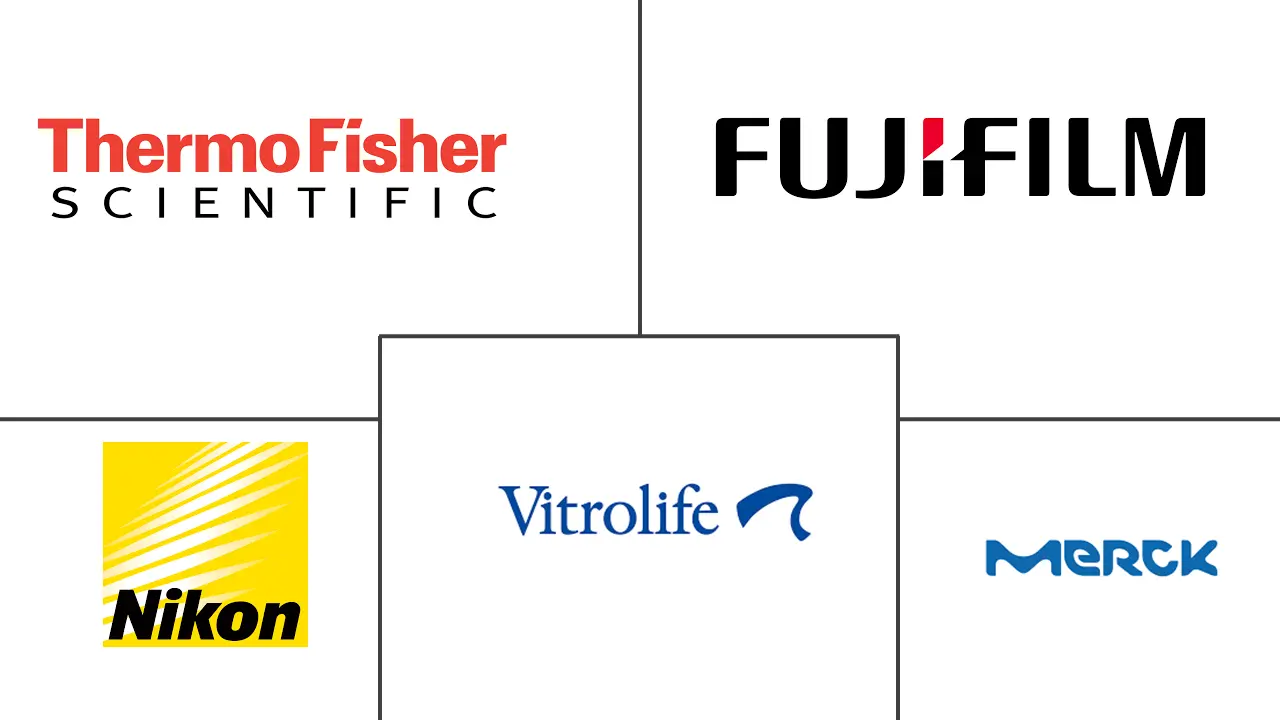
*Disclaimer: Major Players sorted in no particular order |
Need a report that reflects how COVID-19 has impacted this market and its growth?
In Vitro Fertilization Market Analysis
The Global In Vitro Fertilization Market size is expected to grow from USD 24.46 billion in 2023 to USD 35.60 billion by 2028, at a CAGR of 7.80% during the forecast period (2023-2028).
The impact of the COVID-19 pandemic on the studied market is expected to be significant as most countries around the world have already adopted strategies to reduce and eliminate coronavirus infections leading to the closures of fertility centers. The COVID-19 pandemic triggered the worldwide suspension of in vitro fertilization treatments, and this had a profound impact on women undergoing IVF procedures. For instance, an article titled "Infertility Management Disruption During the COVID-19 Outbreak in a Middle-Income Country: Patients' Choices, Attitudes, and Concerns" published in October 2021, reported that patients have faced uncertainty regarding the achievability of their long-term fertility goals amidst an atmosphere of general unpredictability for the duration and extent of disruption of their treatment, combined with the fear of infection. Moreover, it also reported that COVID-19 infection not only affected the patients' performance or ovarian reserve in the immediate subsequent IVF cycle, but it also resulted in a reduced proportion of top-quality embryos. Thus, COVID-19 had a significant impact on the growth of the market.
The rising success rate of IVF technology, increasing awareness about IVF procedures, and delayed onset of pregnancy are the main driving factors for this market. The increasing awareness of advanced in vitro fertilization (IVF) techniques and rising success rates of IVF have stimulated the demand for in vitro fertilization techniques worldwide.
Furthermore, the National Perinatal and Statistics Unit, September 2021 report, demonstrated that IVF success rates have improved significantly over the last 10 years, and the live birth rate per initiated IVF cycle in women using their eggs increased by 18% overall, with an even steeper improvements in older age groups. The overall live birth rate per embryo transfer was increased by up to 28% in 2020. The improved success rates are due to many factors, including advancements in laboratory techniques and improvements in the overall management of couples experiencing infertility, such as lifestyle interventions, improved diagnostic capabilities, and in some cases surgery before IVF.
Another reason driving this market is rising cases of infertility. For instance, according to the article titled "In vitro Fertilization" updated in May 2022, globally 10–12% of couples have difficulty conceiving, and this number is expected to gradually increase in the coming years. IVF accounts for 1.6% and 4.5% of all live births in the United States and Europe, respectively. Also, the same article quoted that approximately 25% to 35% of infertile women are found to have tuboperitoneal disease, with pelvic inflammatory disease (PID) being the most common cause of infertility and poor semen quality in men is the sole cause of infertility in 20% of couples. Infertility affects approximately 1 in 8 couples in the United States. In the last three decades, over 5 million children worldwide have been conceived via IVF technology. Thus, infertility-related problems among couples have stimulated the demand for in vitro fertilization techniques worldwide.
The proportion of women intentionally delaying pregnancies beyond the age of 35 has been increasing in the past few years. A delay in pregnancy commonly causes infertility. In many cases, delayed pregnancies result in pregnancy-related complications and an increased risk of infertility. For instance, as per the Centers for Disease Control and Prevention (CDC) update in March 2022, among heterosexual women aged 15 to 49 years with no prior births, about 1 in 5 (19%) are unable to get pregnant after one year of trying (infertility). Also, about 1 in 4 (26%) women in this group have difficulty getting pregnant or carrying a pregnancy to term (impaired fecundity).
The growing awareness and advancements in IVF technology, the rising number of delayed pregnancies, and increasing infertility among couples are the reasons that boosted the IVF market. For instance, in December 2021, Multiply, an IVF-tech firm, unveiled an AI-based platform designed to replace traditional operations in IVF facilities.
Thus, owing to the abovementioned factors, the market is expected to project growth over the forecast period. However, the market's growth is expected to be limited over the forecast period due to the complications associated with IVF and the associated socio-ethical issues.
In Vitro Fertilization Market Trends
This section covers the major market trends shaping the In Vitro Fertilization Market according to our research experts:
The Sperm Separation Systems Segment is Estimated to Hold the Large Share in Terms of Revenue Over the Forecast Period
In most assisted reproductive technologies (ART), such as in vitro fertilization (IVF) and artificial insemination, sperm separation systems are used. These systems are critical for assisted reproductive technologies (ARTs) because they provide purified samples that can be used in subsequent procedures. These systems are crucial for ARTs as they provide purified samples for further procedures. Furthermore, the rising focus of companies on developing novel devices for use in assisted reproductive technology (ART) procedures conducted by fertility clinics and obstetrician-gynecologist (OB/GYN) practices is driving the market growth.
Sperm selection is crucial to assisted reproduction, influencing the success rate of the treatment cycle and offspring health. Although, in the current clinical sperm selection practices, bypassing almost all the natural selection barriers is a major concern. Additionally, the increasing focus of market players on developing novel devices for use in assisted reproductive technology (ART) procedures performed by fertility clinics and obstetrician-gynecologist (OB/GYN) practices is one of the major driving forces. For instance, in October 2020, Trivector Biomed LLP introduced the ZyMōt sperm separation device, a new-age ‘Lab-On-Chip’ IVF solution in India. These separation devices are cutting-edge lab-on-a-chip technologies that use microfluidics and micro-filtration technology to efficiently isolate the healthiest, fastest-progressing sperm for the best possible results. Thus, as the male factor accounts for nearly half of all infertility cases, the development of a novel method that eliminates many potentially harmful phases of sperm handling in the lab is a much-needed medical intervention in the IVF field, and thus it is expected to drive the growth of the market.
Technological advancements in the sperm separation segment is another reason for driving the market segment. For instance, in March 2022, Malta, in an international collaboration with Pera Labs’s commercialization advisors at the University City Science Center, started the research and development of an AI-powered sperm and egg selection technology for fertility treatments. Pera Labs’s Malta operations have been accelerated by the EUR 800,000 of financial support from Malta Enterprise, coupled with Pera Labs’s financing.
The use of sperm syringes to select high-quality sperm is another reason to drive this market segment. For instance, an article titled, "Sperm Syringe: 3D Sorting Platform for Assisted Reproduction" published in March 2022 reported that a sperm syringe provides the maximum contact area between 1.5 ml of the semen sample and selection events, thereby enabling a highly parallelized and rapid sorting mechanism. This retrieval efficiency provides a sufficient volume and number of high-quality sperm for droplet-based IVF and intrauterine insemination (IUI) to more frequently avoid the more invasive intracytoplasmic sperm injections (ICSI) procedure.
Therefore, due to the rapid advancements in technology and accuracy of sperm selection procedures, the sperm separation systems segment is expected to witness significant growth over the forecast period.
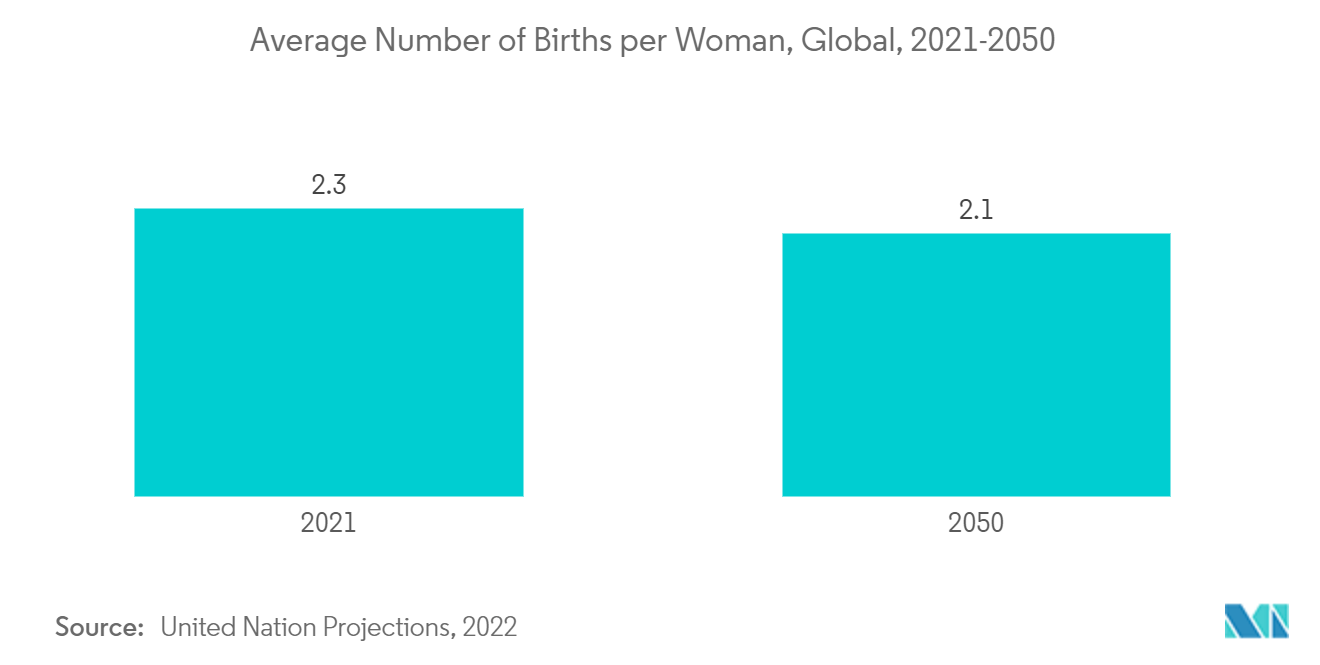
North America Holds a Significant Share in the Market, and it is Expected to do the Same over the Forecast Period
The North American market dominates due to the presence of various leading players in this region, the regulatory reforms, the rising prevalence of associated conditions such as polycystic ovary syndrome (PCOS), standardization of procedures, government funding for sperm and egg storage, and a constant rise in the incidence of infertility in both sexes are all the reasons to drive in vitro fertilization treatment procedures in North America.
The increasing incidence of infertility is also boosting the growth of the market. For instance, in the SingleCare online survey released in February 2021, reported that in 2020, 20% of respondents received in vitro fertilization (IVF) in the United States. In addition, 19% of respondents said they had polycystic ovarian syndrome (PCOS), and 25% said they were infertile for unknown reasons. As a result, the market's growth is being fueled by the high incidence of infertility.
Infertility treatment device demand is being driven by factors such as newly opened fertility centers and reimbursement policies for infertility treatment. For example, as of August 2020, 19 states had passed fertility insurance coverage laws, 13 of which covered IVF, and 10 states had passed fertility preservation laws for iatrogenic (medically-induced) infertility. As a result, the rate of treatment will rise, and the demand for fertility treatment devices will rise as well. Additionally, in September 2020, Inception Fertility (Inception) launched a new network of clinics in Atlanta and Georgia named Pathways Fertility (Pathways) to shift the paradigm of the fertility market and enhance the patient experience. This may boost the treatment rate among the infertile population, thereby positively influencing regional growth.
Furthermore, the presence of well-established market players, newly launched products, and rising product approvals all contribute to market expansion. For instance, in 2021, Cooper Companies acquired Generate Life Sciences, one of the leading providers of donor eggs and sperm for fertility treatments, fertility cryopreservation services, and newborn stem cell storage (cord blood and cord tissue). With this acquisition, CooperSurgical can offer fertility clinics and Obstetrics and Gynaecology an even stronger services and products.
Thus, owing to the abovementioned factors, the North American region in vitro fertilization market is expected to show growth over the forecast period.
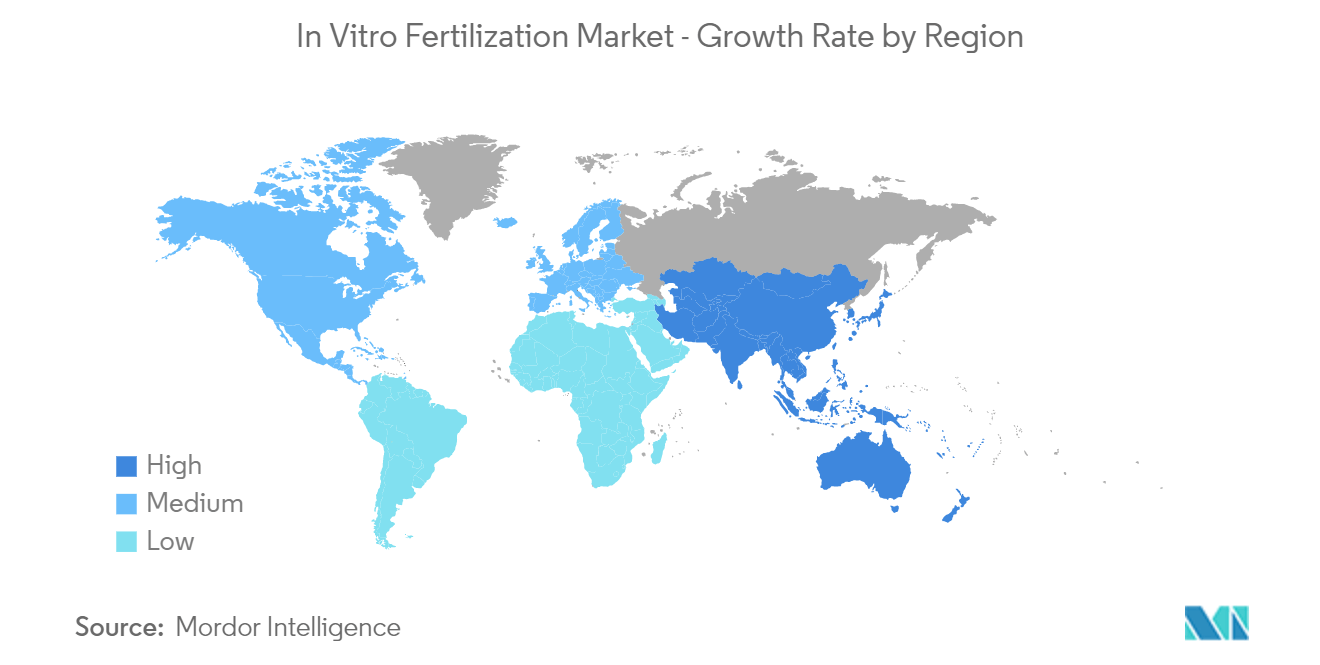
In Vitro Fertilization Industry Overview
The in vitro fertilization market is fragmented in nature due to the presence of several companies operating globally as well as regionally. The competitive landscape includes an analysis of a few international as well as local companies which hold the market shares, including Cook Group Incorporated, Cooper Surgical Inc., Fujifilm Holdings Corporation, Genea Biomedx Pty Ltd, Hamilton Thorne Ltd., Merck KGaA, Nidacon International AB, Nikon Corporation, Thermo Fisher Scientific Inc., Vitrolife AB, INVO Bioscience, Esco Micro Pte Ltd, IVFtech APS, Oxford Gene Technology, Kitazato Corporation, Rocket Medical PLC, Ovascience Inc., Bayer AG, Progyny Inc., and Boston IVF, among others.
In Vitro Fertilization Market Leaders
Thermo Fisher Scientific Inc.
Vitrolife AB
Fujifilm Corporation
Merck KGaA
Nikon Corporation
*Disclaimer: Major Players sorted in no particular order
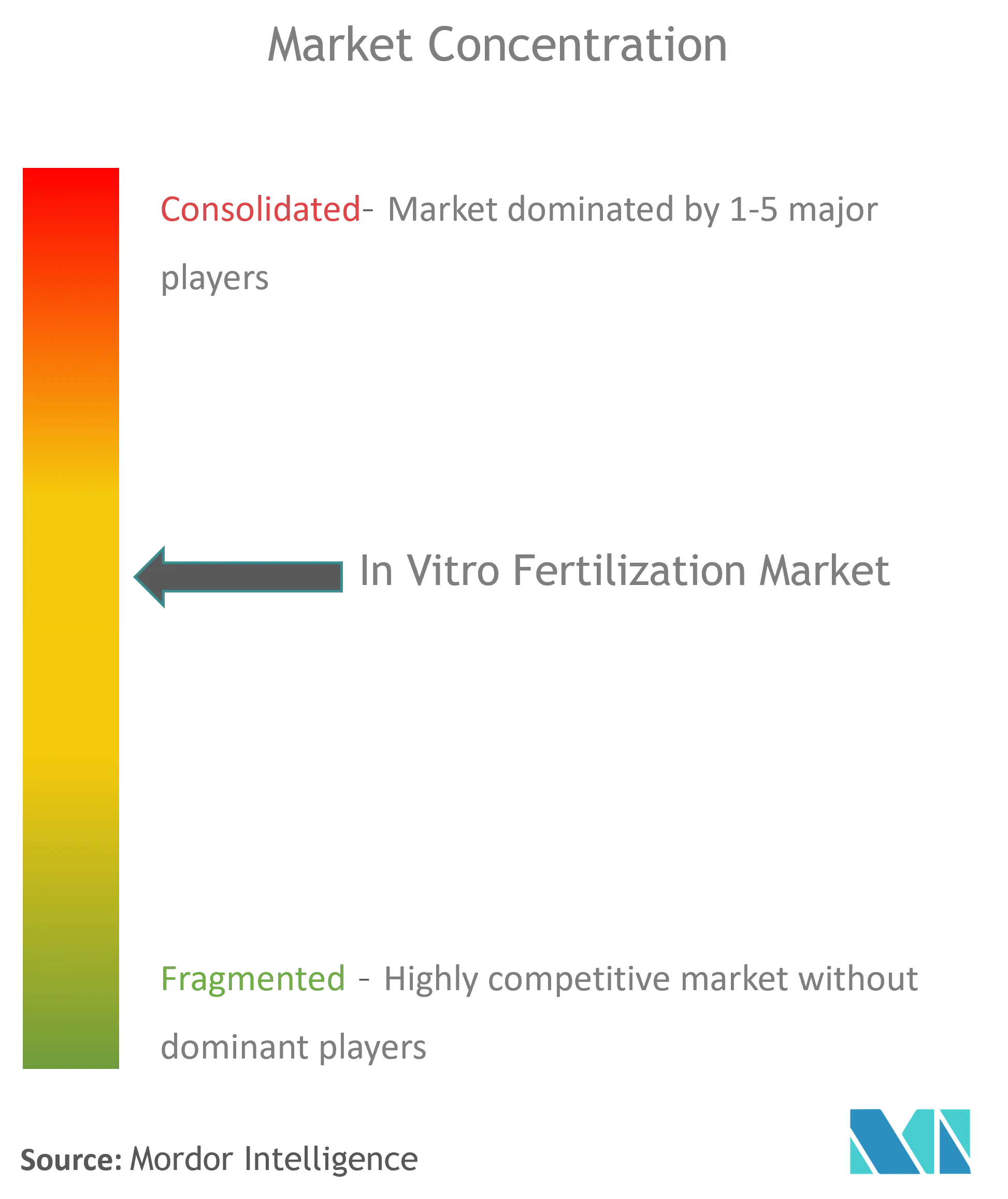
In Vitro Fertilization Market News
- In June 2022, Oma Fertility emerges from stealth and introduces a first-of-its-kind network of fertility clinics, offering families science-forward, AI-informed fertility treatments, paving the way for a new standard in IVF success rates.
- In January 2022, Boston IVF, one of the world’s most experienced fertility providers, signed a partnership with the Delaware Institute for Reproductive Medicine (DIRM). The unique partnership aims to deliver world-class fertility treatments and care locally through innovative treatments like in vitro fertilization (IVF), preimplantation genetic testing, male infertility, and others.
In Vitro Fertilization Market Report - Table of Contents
1. INTRODUCTION
1.1 Study Assumptions and Market Definition
1.2 Scope of the Study
2. RESEARCH METHODOLOGY
3. EXECUTIVE SUMMARY
4. MARKET DYNAMICS
4.1 Market Overview
4.2 Market Drivers
4.2.1 Rising Success Rate of IVF Technology
4.2.2 Increasing Awareness about IVF Technology
4.2.3 Delayed Onset of Pregnancies
4.3 Market Restraints
4.3.1 Complications Associated with In Vitro Fertilization
4.3.2 Social Stigma, Ethical, and Legal Issues Associated with In Vitro Fertilization
4.4 Porter's Five Forces Analysis
4.4.1 Threat of New Entrants
4.4.2 Bargaining Power of Buyers/Consumers
4.4.3 Bargaining Power of Suppliers
4.4.4 Threat of Substitute Products
4.4.5 Intensity of Competitive Rivalry
5. MARKET SEGMENTATION (Market Size by Value – USD million)
5.1 By Product
5.1.1 Reagent
5.1.2 Instrument
5.1.2.1 Imaging Systems
5.1.2.2 Incubators
5.1.2.3 Cryosystems
5.1.2.4 IVF Cabinet
5.1.2.5 Ovum Aspiration Pump
5.1.2.6 Sperm Separation Systems
5.1.2.7 Micromanipulator Systems
5.1.2.8 Other Instruments
5.2 By End User
5.2.1 Fertility Clinics
5.2.2 Hospitals
5.2.3 Other End Users
5.3 Geography
5.3.1 North America
5.3.1.1 United States
5.3.1.2 Canada
5.3.1.3 Mexico
5.3.2 Europe
5.3.2.1 Germany
5.3.2.2 United Kingdom
5.3.2.3 France
5.3.2.4 Italy
5.3.2.5 Spain
5.3.2.6 Rest of Europe
5.3.3 Asia-Pacific
5.3.3.1 China
5.3.3.2 Japan
5.3.3.3 India
5.3.3.4 Australia
5.3.3.5 South Korea
5.3.3.6 Rest of Asia-Pacific
5.3.4 Middle East and Africa
5.3.4.1 GCC
5.3.4.2 South Africa
5.3.4.3 Rest of Middle East and Africa
5.3.5 South America
5.3.5.1 Brazil
5.3.5.2 Argentina
5.3.5.3 Rest of South America
6. COMPETITIVE LANDSCAPE
6.1 Company Profiles
6.1.1 Cook Group Incorporated
6.1.2 CooperSurgical Inc.
6.1.3 Fujifilm Holdings Corporation
6.1.4 Genea Biomedx Pty Ltd
6.1.5 Hamilton Thorne Ltd
6.1.6 Merck KGaA
6.1.7 Nidacon International AB
6.1.8 Nikon Corporation
6.1.9 Thermo Fisher Scientific Inc.
6.1.10 Vitrolife AB
6.1.11 INVO Bioscience
6.1.12 IVFtech APS
6.1.13 Oxford Gene Technology
6.1.14 Kitazato Corporation
6.1.15 Rocket Medical PLC
6.1.16 Ovascience Inc.
6.1.17 Bayer AG
6.1.18 Boston IVF
- *List Not Exhaustive
7. MARKET OPPORTUNITIES AND FUTURE TRENDS
In Vitro Fertilization Industry Segmentation
As per the scope of the report, in vitro fertilization is an assistive reproductive technology that involves the process of fertilization by retrieving eggs from the woman's ovaries and fertilizing them with sperm outside of the body in a laboratory environment. The In Vitro Fertilization Market is Segmented by Product Type (Reagent and Instrument (Imaging Systems, Incubators, Cryosystems, IVF Cabinet, Ovum Aspiration Pump, Sperm Separation Systems, Micromanipulator Systems, and Other Instruments)), End User (Fertility Clinics, Hospitals, and Other End Users), and Geography (North America, Europe, Asia-Pacific, Middle East and Africa, and South America). The market report also covers the estimated market sizes and trends for 17 different countries across major regions, globally. The report offers the value (USD million) for all the above segments.
| By Product | ||||||||||
| Reagent | ||||||||||
|
| By End User | |
| Fertility Clinics | |
| Hospitals | |
| Other End Users |
| Geography | ||||||||
| ||||||||
| ||||||||
| ||||||||
| ||||||||
|
In Vitro Fertilization Market Research FAQs
How big is the Global In Vitro Fertilization Market?
The Global In Vitro Fertilization Market size is expected to reach USD 24.46 billion in 2023 and grow at a CAGR of 7.80% to reach USD 35.60 billion by 2028.
What is the current Global In Vitro Fertilization Market size?
In 2023, the Global In Vitro Fertilization Market size is expected to reach USD 24.46 billion.
Who are the key players in Global In Vitro Fertilization Market?
Thermo Fisher Scientific Inc., Vitrolife AB, Fujifilm Corporation, Merck KGaA and Nikon Corporation are the major companies operating in the Global In Vitro Fertilization Market.
Which is the fastest growing region in Global In Vitro Fertilization Market?
Asia Pacific is estimated to grow at the highest CAGR over the forecast period (2023-2028).
Which region has the biggest share in Global In Vitro Fertilization Market?
In 2023, the North America accounts for the largest market share in the Global In Vitro Fertilization Market.
In Vitro Fertilization Industry Report
Statistics for the 2023 In Vitro Fertilization market share, size and revenue growth rate, created by Mordor Intelligence™ Industry Reports. In Vitro Fertilization analysis includes a market forecast outlook to 2028 and historical overview. Get a sample of this industry analysis as a free report PDF download.
